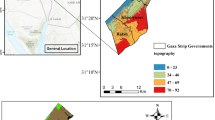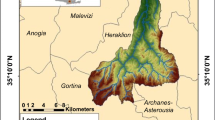Abstract
Flash floods are highly devastating, however there is no effective management for their water in Saudi Arabia, therefore, it is crucial to adopt Rainfall Water Harvesting (RWH) techniques to mitigate the flash floods and manage the available water resources. The goal of this study is to create a potential flood hazard map and a map of suitable locations for RWH in Wadi Nisah, Saudi Arabia to identify potential areas for rainwater harvesting and dam construction for both a flood mitigation and water harvesting. This research was carried out using a spatiotemporal distributed model based on multi-criteria decision analysis by combining Geographic Information System (GIS), Remote Sensing (RS), and Multi-Criteria Decision-Making tools (MCDM). The flood hazard mapping criteria were elevation, drainage density, slope, direct runoff depth at 50 years return period, Topographic witness index, and Curve Number, while the criteria for RWH were Slope, Land cover, Stream order, Lineaments density, and Average of annual max-24 h Rainfall. In multi-criteria decision analysis, 21.55% of the total area for Wadi Nisah was classified as extremely dangerous and dangerous; 65.29% of the total area was classified as moderate; and 13.15% of the total area was classified as safe and very safe in flash flood hazard classes. Only 15% of Wadi Nisah has a very high potentiality for RWH and 27.7%, 57.31% of the basin has a moderate and a low or extremely low potentiality of RWH, respectively. ranged from 3976104.499 m3 to 4328509.123 m3; and the maximum surface area of reservoirs ranged from 1268372.63 m2 to 1505825.676.14 m2.














Similar content being viewed by others
Availability of Data and Materials
The datasets generated during and/or analysed during the current study are available from the corresponding author on reasonable request.
References
Abdelkader MM, Al-Amoud AI, El Alfy M et al (2021) Assessment of flash flood hazard based on morphometric aspects and rainfall-runoff modeling in Wadi Nisah, central Saudi Arabia. Remote Sens Appl Soc Environ 23:100562. https://doi.org/10.1016/J.RSASE.2021.100562
Abdulla F (2020) Rainwater harvesting in Jordan: potential water saving, optimal tank sizing and economic analysis. Urban Water J 17:446–456. https://doi.org/10.1080/1573062X.2019.1648530
Abushandi E, Alatawi S (2015) Dam site selection using remote sensing techniques and geographical information system to control flood events in Tabuk City. Hydrol Curr Res 6:1–13. https://doi.org/10.4172/2157-7587.1000189
Agarwal A (1977) Coaxing the barren deserts back to life. New Sci
Al-Ghobari H, Dewidar AZ (2021) Integrating GIS-based MCDA techniques and the SCS-CN method for identifying potential zones for rainwater harvesting in a semi-arid area. Water 13:704. https://doi.org/10.3390/W13050704
Almazroui M (2012) The life cycle of extreme rainfall events over western Saudi Arabia simulated by a regional climate model: Case study of November 1996. Atmósfera 25:23–41. https://www.scielo.org.mx/scielo.php?pid=S0187-62362012000100002&script=sci_abstract&tlng=en
Alsharhan AS, Rizk ZA, Nairn AEM et al (2001) Hydrogeology of an arid region: the Arabian Gulf and adjoining areas. Elsevier
Ammar A, Riksen M, Ouessar M, Ritsema C (2016) Identification of suitable sites for rainwater harvesting structures in arid and semi-arid regions: A review. Int Soil Water Conserv Res 4:108–120. https://doi.org/10.1016/j.iswcr.2016.03.001
Bowler DG, Turner MA (1977) Water harvesting on a yellow-grey earth. In: Proceedings of the New Zealand grassland association. pp 156–160
Burdass WJ (1975) Water harvesting for livestock in Western Australia. Proc Water Harvest Syrup, Phoenix, AZ, ARS W-22~ USDA 8–26
Chakraborty A, Joshi PK (2016) Mapping disaster vulnerability in India using analytical hierarchy process. Geomat Nat Hazards Risk 7:308–325. https://doi.org/10.1080/19475705.2014.897656
Chiarella J V, Beck WH (1975) Water harvesting catchments on Indian lands in the Southwest. In: Proc. Water Harvesting Symp., Phoenix, AZ, ARS W-22~ USDA. pp 104–114
Estoque RC, Murayama Y (2010) Suitability analysis for beekeeping sites in La Union, Philippines, using GIS and multi-criteria evaluation techniques. Res J Appl Sci 5:242–253. https://doi.org/10.3923/rjasci.2010.242.253
Evenari M, Shanan L, Tadmor N (1982) The Negev: the challenge of a desert. Harvard University Press
Kahinda JM, Lillie ESB, Taigbenu AE et al (2008) Developing suitability maps for rainwater harvesting in South Africa. Phys Chem Earth, Parts A/B/C 33:788–799. https://doi.org/10.1016/j.pce.2008.06.047
Kazakis N, Kougias I, Patsialis T (2015) Assessment of flood hazard areas at a regional scale using an index-based approach and analytical hierarchy process: Application in Rhodope-Evros region, Greece. Sci Total Environ 538:555–563. https://doi.org/10.1016/j.scitotenv.2015.08.055
Le Cozannet G, Garcin M, Bulteau T et al (2013) An AHP-derived method for mapping the physical vulnerability of coastal areas at regional scales. Nat Hazards Earth Syst Sci 13:1209–1227. https://doi.org/10.5194/nhess-13-1209-2013
Mahmoud SH, Alazba AA (2014) Identification of potential sites for groundwater recharge using a GIS-based decision support system in Jazan region-Saudi Arabia. Water Resour Manag 28:3319–3340. https://doi.org/10.1007/s11269-014-0681-4
Marinoni O (2004) Implementation of the analytical hierarchy process with VBA in ArcGIS. Comput Geosci 30:637–646. https://doi.org/10.1016/J.CAGEO.2004.03.010
Matomela N, Li T, Ikhumhen HO (2020) Siting of rainwater harvesting potential sites in arid or semi-arid watersheds using GIS-based techniques. Environ Process 7:631–652. https://doi.org/10.1007/s40710-020-00434-7
Mickelson RH (1975) Performance and durability of sheet metal, butyl rubber, asphalt roofing, and bentonite for harvesting precipitation. In: Proc. Water Harvesting Symp. USDA, pp 93–102
Minatour Y, Khazaie J, Ataei M, Javadi AA (2015) An integrated decision support system for dam site selection. Sci Iran 22:319–330
Myhrman M, Cluff CB, Putnam F (1978) Rainfall-runoff relationships for a mountain watershed in Southern Arizona. Arizona-Nevada Acad Sci
Nejad ARV, Esmaeili S, Aghamohammadi H (2015) Earthquake risk modeling using GIS for urban buildings, case study: Tehran municipality, district 3. Adv Nat Appl Sci 9:36–43
Orencio PM, Fujii M (2013) A localized disaster-resilience index to assess coastal communities based on an analytic hierarchy process (AHP). Int J Disaster Risk Reduct 3:62–75. https://doi.org/10.1016/j.ijdrr.2012.11.006
Ouma YO, Tateishi R (2014) Urban flood vulnerability and risk mapping using integrated multi-parametric AHP and GIS: methodological overview and case study assessment. Water 6:1515–1545. https://doi.org/10.3390/w6061515
Papaioannou G, Vasiliades L, Loukas A (2015) Multi-criteria analysis framework for potential flood prone areas mapping. Water Resour Manag 29:399–418. https://doi.org/10.1007/s11269-014-0817-6
Pourghasemi HR, Beheshtirad M, Pradhan B (2016) A comparative assessment of prediction capabilities of modified analytical hierarchy process (M-AHP) and Mamdani fuzzy logic models using Netcad-GIS for forest fire susceptibility mapping. Geomat Nat Hazards Risk 7:861–885. https://doi.org/10.1080/19475705.2014.984247
Rahaman SA, Ajeez SA, Aruchamy S, Jegankumar R (2015) Prioritization of sub watershed based on morphometric characteristics using fuzzy analytical hierarchy process and geographical information system–A study of Kallar Watershed, Tamil Nadu. Aquat Procedia 4:1322–1330. https://doi.org/10.1016/j.aqpro.2015.02.172
Rana VK, Suryanarayana TMV (2020) GIS-based multi criteria decision making method to identify potential runoff storage zones within watershed. Ann GIS 26:149–168. https://doi.org/10.1080/19475683.2020.1733083
Robinson J (2006) DCR dam safety technical advisory table 1 briefing, department of conservation and recreation. Coserving virginia’s Nat Recreat Resour USA
Saaty RW (1987) The analytic hierarchy process—what it is and how it is used. Math Model 9:161–176. https://doi.org/10.1016/0270-0255(87)90473-8
Saaty TL (1990) How to make a decision: the analytic hierarchy process. Eur J Oper Res 48:9–26. https://doi.org/10.1016/0377-2217(90)90057-I
Saley MB, Danumah JH, Sorokoby VM et al (2013) Méthodologie pour la cartographie des zones vulnerables a l’inondation par systeme d’information géographique et analyse multicritère: application au bassin versant de la Davo a Sassandra (sud-ouest de la Cote d’Ivoire). Africa Geosci Rev 20:21–33
Savane I, Coulibaly N, Soro N (2003) Analyse multicritère spatiale pour l’identification de la vulnérabilité aux risques naturels d’Abobo (banlieue de la ville d’Abidjan, Côte d’Ivoire). Rev Ivoir Sci Technol 4:94–107
Sayl KN, Muhammad NS, Yaseen ZM, El-shafie A (2016) Estimation the physical variables of rainwater harvesting system using integrated GIS-based remote sensing approach. Water Resour Manag 30:3299–3313. https://doi.org/10.1007/s11269-016-1350-6
Singh LK, Jha MK, Chowdary VM (2017) Multi-criteria analysis and GIS modeling for identifying prospective water harvesting and artificial recharge sites for sustainable water supply. J Clean Prod 142:1436–1456. https://doi.org/10.1016/J.JCLEPRO.2016.11.163
Singhai A, Das S, Kadam AK et al (2019) GIS-based multi-criteria approach for identification of rainwater harvesting zones in upper Betwa sub-basin of Madhya Pradesh, India. Environ Dev Sustain 21:777–797. https://doi.org/10.1007/s10668-017-0060-4
Sivanappan RK (2006) Rain water harvesting, conservation and management strategies for urban and rural sectors. In: National Seminar on Rainwater Harvesting and Water Management. p 1
Smith GL (1978) Water harvesting technology applicable to semiarid, subtropical climates. PhD Thesis. Colorado State University. Libraries
Wang Y, Li Z, Tang Z, Zeng G (2011) A GIS-based spatial multi-criteria approach for flood risk assessment in the Dongting Lake Region, Hunan, Central China. Water Resour Manag 25:3465–3484. https://doi.org/10.1007/s11269-011-9866-2
Xiao Y, Yi S, Tang Z (2016) GIS-based multi-criteria analysis method for flood risk assessment under urbanization. In: 2016 24th International Conference On Geoinformatics. IEEE, pp 1–5
Yahaya S, Ahmad N, Abdalla RF (2010) Multicriteria analysis for flood vulnerable areas in Hadejia-Jama’are River basin, Nigeria. Eur J Sci Res 42:71–83
Yalcin A (2008) GIS-based landslide susceptibility mapping using analytical hierarchy process and bivariate statistics in Ardesen (Turkey): comparisons of results and confirmations. Catena 72:1–12. https://doi.org/10.1016/j.catena.2007.01.003
Yasser M, Jahangir K, Mohmmad A (2013) Earth dam site selection using the analytic hierarchy process (AHP): a case study in the west of Iran. Arab J Geosci 6:3417–3426
Funding
Authors would acknowledge the support from Researchers Supporting Project number (RSP2023R297), King Saud University, Riyadh, Saudi Arabia.
Author information
Authors and Affiliations
Contributions
Conceptualization M M. A, AE. F; Methodology: M M. A, AE. Formal analysis: M M. A; Investigation: M M. A, AE. F; Writing—original draft; M M. A, M. S; writing—review & editing M M. A, AE. F, M. S, F.M.A; funding acquisition: M. A; A. A; AE. F, M. S, F.M.A; Resources; M. A; AE. F; Supervision; M. A; AE. F, M. S.
Corresponding author
Ethics declarations
Ethical Approval
The study doesn’t require ethical approval because it did not include human participants or animals.
Informed Consent
Informed consent wasn’t obtained from all individual participants included in this paper because it did not include human participants or animals.
Consent to Publish
Publish consent wasn’t obtained from all individual participants included in this paper because it did not include human participants or animals.
Conflicts of Interest
The authors declare that they have no known competing financial interests or personal relationships that could have appeared to influence the work reported in this paper.
Additional information
Publisher's Note
Springer Nature remains neutral with regard to jurisdictional claims in published maps and institutional affiliations.
Supplementary Information
Below is the link to the electronic supplementary material.
Rights and permissions
Springer Nature or its licensor (e.g. a society or other partner) holds exclusive rights to this article under a publishing agreement with the author(s) or other rightsholder(s); author self-archiving of the accepted manuscript version of this article is solely governed by the terms of such publishing agreement and applicable law.
About this article
Cite this article
Abd-el-Kader, M.M., El-Feky, A.M., Saber, M. et al. Designating Appropriate Areas for Flood Mitigation and Rainwater Harvesting in Arid Region Using a GIS-based Multi-criteria Decision Analysis. Water Resour Manage 37, 1083–1108 (2023). https://doi.org/10.1007/s11269-022-03416-6
Received:
Accepted:
Published:
Issue Date:
DOI: https://doi.org/10.1007/s11269-022-03416-6




